Guest post from Adam Hutter, director of the Department of Homeland Security Science and Technology Directorate (S&T) First Responders Group’s (FRG) National Urban Security Technology Laboratory (NUSTL)
The National Urban Security Technology Laboratory celebrates another exceptional year in which we delivered on our mission to test, evaluate, and analyze homeland security capabilities, while serving as a technical advisor to the first responders protecting our nation’s cities. With offices in downtown Chicago and New York City, NUSTL works directly with state and local first responders and uses our metropolitan locations as urban test environments for the diverse technologies being developed to prepare and protect our nation.
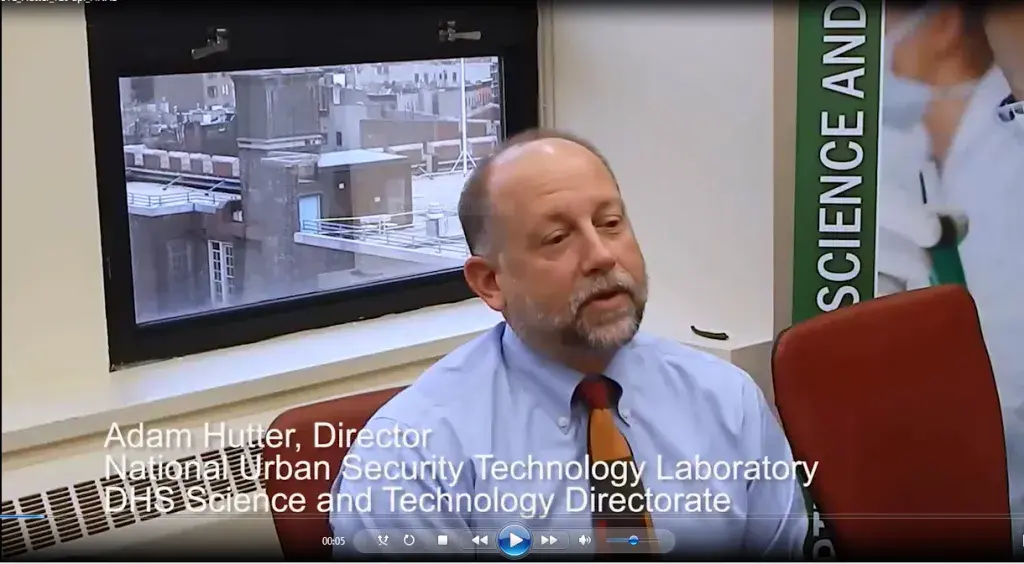 Our team’s daily interactions with first responders and homeland security representatives position NUSTL to bridge between technology developers and end users. We relay first responder issues and needs to developers while advising first responders on innovative solutions from the technology development community. Our laboratory also manages a portfolio of research and development programs addressing response and recovery from the effects of radiological or nuclear events.
Our team’s daily interactions with first responders and homeland security representatives position NUSTL to bridge between technology developers and end users. We relay first responder issues and needs to developers while advising first responders on innovative solutions from the technology development community. Our laboratory also manages a portfolio of research and development programs addressing response and recovery from the effects of radiological or nuclear events.Before looking forward, we at NUSTL took an opportunity to reflect on our major accomplishments in 2015.
NUSTL Conducted S&T’s First Urban Operational Experimentation (OpEx)
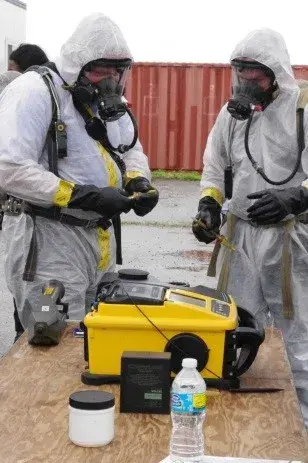 A major accomplishment included the S&T Urban OpEx, which occurred in July 2015. It enabled first responders and technology innovators to collaborate and experiment with eight cutting-edge response technologies in realistic urban operational scenarios. Through these experiments, first responders had the opportunity to provide feedback directly to the developers.
A major accomplishment included the S&T Urban OpEx, which occurred in July 2015. It enabled first responders and technology innovators to collaborate and experiment with eight cutting-edge response technologies in realistic urban operational scenarios. Through these experiments, first responders had the opportunity to provide feedback directly to the developers.Participating first responders from across the nation reviewed their own operational requirements and gathered valuable insights to help guide future technology investments. Lastly, Urban OpEx supported S&T’s own technology scouting efforts, as engagement with stakeholders and technology developers provided opportunities for S&T to learn more about what to look for in the future and what the marketplace looks like.
Our NUSTL staff members also developed experimentation reports, which assessed several S&T technologies tested during the Urban OpEx. These reports are publicly available on FirstResponder.gov and can be accessed at the links below.
- X-ray Scanning Rover: an S&T-developed custom robot that is designed to rapidly screen suspicious packages using X-ray technology
- Internet of Things Networks for First Responders: a wireless communication and networking technology that seeks to address the problem of communicating through dense concrete structures
- Knight Robot: an unmanned ground vehicle capable of drilling holes, shattering glass and inserting a mounted camera into containers and vehicles that may contain suspicious items
- Tridion-9: a gas chromatograph mass spectrometer that provides identification of volatile and semi-volatile organic hazards in the field in less than three minutes (pictured above with two New York City Fire Department [FDNY] HazMat Operations responders)
- BioFlash-E: a biological identifier that collects and analyzes atmospheric aerosol samples for a suite of biological pathogens
- FIDO B2: a networked, bio-active clarifier bio-aerosol detector that alarms when it detect san airborne bio-threat
- RepKnight: an open-source data platform that performs real-time monitoring and analysis of social media using keywords, trends and sentiment
- Situational Heads Up Display: a small screen display fitted onto a respirator to help first responders be aware of their position and surrounding environment
NUSTL staff members led the event planning, technology selection, scenario development, and outreach efforts for the Urban OpEx event. S&T’s Deputy Under Secretary Dr. Robert Griffin kicked off day one of Urban OpEx at the New York City Emergency Management’s Emergency Operations Center. Attendees and leadership deemed the event a success, including S&T Under Secretary Dr. Reginald Brothers as well as Research and Development Partnerships Director Jay Martin, agency representatives from the New York City Police Department, FDNY, New York City Emergency Management, Port Authority of New York and New Jersey and First Responder Resource Group representatives from around the country. Planning has commenced for Urban OpEx 2016, tentatively scheduled to take place this October. Stay tuned for more details!
Radiological Emergency Management System (REMS) Installed at New York’s Grand Central Terminal (GCT)
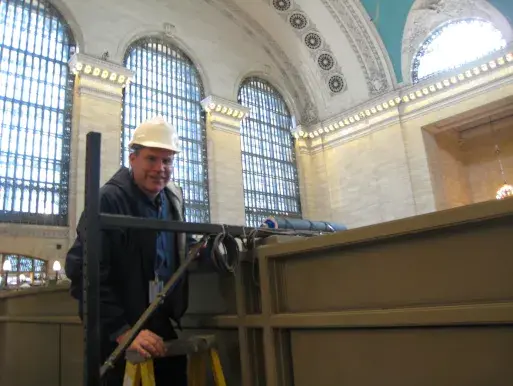 Another prominent 2015 highlight was our physical installation of REMS inside New York City’s GCT. NUSTL developed the REMS concept as a radiation sensor network to assist response and recovery after an accidental or deliberate release of radiation in an urban area. It was field tested over a six-year period and is currently deployed by the NYPD to monitor radiation levels in and around New York City.
Another prominent 2015 highlight was our physical installation of REMS inside New York City’s GCT. NUSTL developed the REMS concept as a radiation sensor network to assist response and recovery after an accidental or deliberate release of radiation in an urban area. It was field tested over a six-year period and is currently deployed by the NYPD to monitor radiation levels in and around New York City.While the REMS network is currently deployed throughout New York City in outdoor locations, this GCT installation is the first of its kind in the nation at an indoor, major transportation facility. NUSTL physicist Paul Goldhagen and electrical engineer Brian Albert (pictured above) worked with Metropolitan Transportation Authority (MTA) personnel to install the sensors, which will continuously monitor radiation levels and alert emergency management officials when levels are abnormally elevated within the terminal. In addition to detecting high radiation levels, REMS also distinguishes real threats from false alarms, such as those caused by medical patients who have been treated with radioactive materials.
This REMS installation was a major milestone for our Radiological Incident Awareness System and Concept of Operations (CONOPS) Development project, through which the laboratory advises first responder agencies on the development of CONOPS for monitoring infrastructure to respond to radiological incidents. While the MTA currently deploys sensor technology to detect chemical, biological, and radiological threats, they are always looking to improve operational plans and expand capabilities to respond to incidents in their terminal.
NUSTL Conducted a Standoff Radiation Detector Assessment
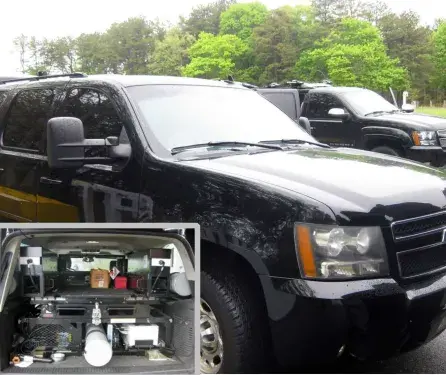 In 2015, we responded to the needs of first responders by conducting an assessment of vehicle-mounted Standoff Radiation Detection (SRD) Systems. An SRD is a type of mobile detection equipment used by first responders to detect radioactive sources and identify radioisotopes from a standoff distance. The demonstrations during the assessment, conducted at Brookhaven National Laboratory, gained interest and enthusiasm from participating first responders, including representatives from the Port Authority of New York and New Jersey, Metropolitan Transportation Authority Police Department, Connecticut State Police, Rockland County Police and a Counter Terrorism Operations Support representative from Hofstra North Shore-Long Island Jewish School of Medicine.
In 2015, we responded to the needs of first responders by conducting an assessment of vehicle-mounted Standoff Radiation Detection (SRD) Systems. An SRD is a type of mobile detection equipment used by first responders to detect radioactive sources and identify radioisotopes from a standoff distance. The demonstrations during the assessment, conducted at Brookhaven National Laboratory, gained interest and enthusiasm from participating first responders, including representatives from the Port Authority of New York and New Jersey, Metropolitan Transportation Authority Police Department, Connecticut State Police, Rockland County Police and a Counter Terrorism Operations Support representative from Hofstra North Shore-Long Island Jewish School of Medicine.This assessment was conducted through NUSTL’s System Assessment and Validation for Emergency Responders (SAVER) program. Through our SAVER program, we conduct test programs, focus groups, and other technology evaluations in the laboratory and in the field alongside end-users. Our development and execution of these events allow first responders to assess equipment performance and capabilities to inform purchasing decisions.
In addition, our assessments focus primarily on answering two main questions from the responder community: “What equipment is available?” and “How does it perform?” We respond to direct requests made from state and local first responders on technologies of interest. For example, the New York City Department of Health and Mental Hygiene (DOHMH) contacted NUSTL for assistance with characterization studies for their new personnel dosimetry system.
In 2016, we will work on the test plan development, coordinate gamma and X-ray test irradiations, and present final results to DOHMH.
NUSTL Scientists Honored at S&T Patent Award Ceremony
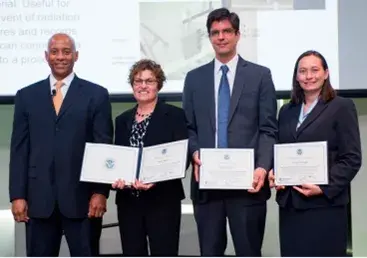 Our NUSTL staff members, physicist Gladys Klemic, test scientist Cecilia Murtagh, and former NUSTL chemist Paul Bailey were honored at the DHS S&T Patent Awards Ceremony for developing DHS’ first-ever patent – a very thin, “card-like” dosimeter. This breakthrough technology was inspired by the Metrocards – used every day by people traveling around New York City – and shaped their vision for a dosimeter with similar convenience.
Our NUSTL staff members, physicist Gladys Klemic, test scientist Cecilia Murtagh, and former NUSTL chemist Paul Bailey were honored at the DHS S&T Patent Awards Ceremony for developing DHS’ first-ever patent – a very thin, “card-like” dosimeter. This breakthrough technology was inspired by the Metrocards – used every day by people traveling around New York City – and shaped their vision for a dosimeter with similar convenience.As a result of our talented and innovative staff, Patent Number 7,781,747 was issued for a wallet-sized plastic card that conveniently measures the amount of radiation on a person or in a given area.
Pictured at left, Under Secretary for Science and Technology Dr. Reginald Brothers stands alongside Klemic, Bailey, and Murtagh holding their patent awards to commemorate this milestone.
North Atlantic Treaty Organization (NATO) Parliamentary Assembly Visited NUSTL
Our global reach grew in numbers and geographic distribution throughout 2015. Among our numerous visitors last year, NUSTL hosted members of the NATO Parliamentary Assembly, Science and Technology Committee (STC). It was a great honor to provide briefings and demonstrations that aligned our shared missions and responsibilities in the homeland security community.
The Assembly serves as the consultative inter-parliamentary organization for the North Atlantic Alliance and recognizes that science and technology play an important role in maintaining both the security and prosperity of the Atlantic Community nations. The NATO Committee included representatives from France, Germany, Hungary, Luxembourg, Norway, Portugal, Slovenia, Spain, Turkey, and the United Kingdom.
Our engagement with NATO allowed for information sharing on the role of technology in homeland security. The NATO visit to NUSTL also contributed to the value S&T places within its international partners and agreements for research collaborations among countries.
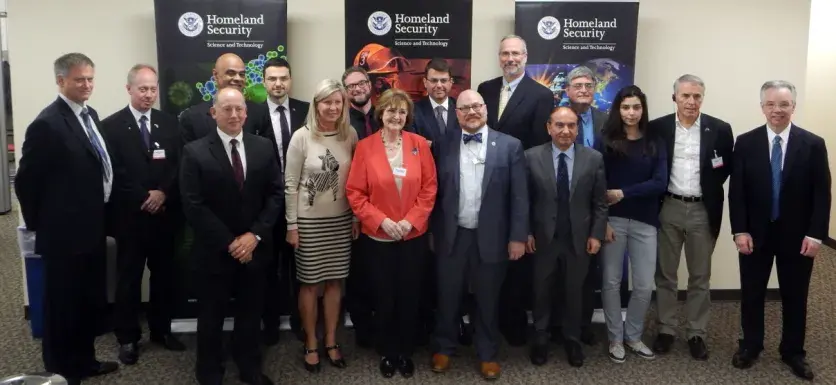
“We sincerely enjoyed our visit to NUSTL and were very impressed by [the] high level of presentations that were given. These briefings certainly gave the parliamentarians an opportunity to gather valuable information that will, without a doubt, be carried back to the debates in their national parliaments.” — Henrik Bliddal, director of the NATO STC on behalf of Baroness Ramsay of Cartvale, chairperson of NATO STC.
Looking Ahead to 2016
NUSTL’s Radiological/Nuclear Response & Recovery (RNRR) team has partnered with the U.S. Environmental Protection Agency’s (EPA) National Homeland Security Research Center and Office of Emergency Management to provide response agencies with scientifically defensible technologies, protocols and best practices to help them respond and recover to a radiological or nuclear incident. The team has developed a Radiological Decontamination Application, which will provide this information in a user friendly format and initiate discussions with response agencies and communities on response strategies for gross decontamination and contamination containment. In 2016, the application will go live and become available to the nation’s emergency response organizations.
Additionally, NUSTL’s RNRR team jointly developed the Science-based Response Planning Guidance for the First 100 Minutes of the Response to a Radiological Dispersal Device (RDD) Detonation with the Department of Energy’s (DOE) Brookhaven National Laboratory and Sandia National Laboratories. Key features from our RNRR team’s guidance tool have been selected and transitioned into RadResponder, a system created by FEMA, DOE and the EPA, and are now widely available for use by first responders in measuring and mapping radiological data during a response.
I am proud and appreciative of having truly meaningful work and making an impact in the security of this nation by supporting our first responders – engaging with them is the lifeblood of NUSTL. Getting their insights, opinions, and picking their brains for operational expertise is important and essential work. That’s why testing and evaluation continues to be an essential part of our mission and why we are engaging with other divisions across the directorate to heighten our involvement in some of S&T’s new and exciting projects.
In 2016, NUSTL will provide testing and evaluation support to S&T’s first Accelerator program, EMERGE, which works to enhance wearable technologies available to first responders. We anticipate our S&T Urban OpEx event in 2016 will build upon the impact of our initial Urban OpEx in 2015. In addition, NUSTL will serve as a test agent for the Next Generation First Responder Apex program, a five-year program aimed to help tomorrow's first responders be more protected, connected, and fully aware.
Finally, NUSTL will provide test and evaluation support during the live testing and demonstrations of first responder communications in an electronic threat environment. This Electronic Warfare exercise is planned to take place at White Sands Missile Range in New Mexico this July.
Stay tuned to dhs.gov/science-and-technology/first-responders and our Facebook page for regular updates on what we do!
Last Updated: 01/24/2024
